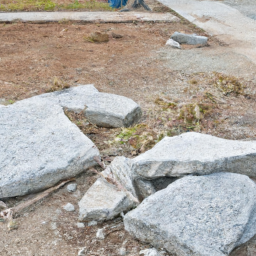How To Move Landscaping Rocks
Table of Contents []
How To Move Landscaping Rocks
Introduction
Moving landscaping rocks can seem daunting. After all, rocks can be large, and they are often heavy. To help you lift, move, and position the stones in your landscaping, here are eight relevant topics. We cover a range of topics related to rock moving, from identifying the right type of rock to gathering the materials needed to make the job easier. We also discuss various design elements to consider before moving the rocks and how to add some extra beauty to your landscaping. Read on for all the details.
Types of Landscaping Rocks
Different types of landscaping rocks have different features and appeal in terms of aesthetics. Some rocks have a more smooth, rounded look, while others may be more jagged. The rocks used in landscaping are usually quite durable, so you won't need to worry about them wearing away too quickly. Some of the more popular types of landscaping rocks include quartzite and granite, sandstone, and limestone.
Materials Needed for Rock Moving
When selecting the materials you need for rock moving, it's important to choose wisely. This includes gloves to protect your hands, something to pick up the rocks, like a shovel or spade, and a dolly to move the rocks around more easily. You will also need a wheelbarrow to transport the rocks from the point of purchase to the area where you will be placing them. Depending on the weight and shape of the rocks that you choose, other items may be necessary to help you safely move them, such as a jack.
Design Elements
Before you start moving the rocks, it's important to consider the design elements. This includes the type of rocks that you select, the placement of the rocks in relation to the other plants and structures, and how the rocks fit into the overall landscape. You also need to consider ways to protect the rocks from various hazards, such as wind and water erosion. It's also a good idea to think about how to make the rocks easy to move and reposition.
Planting Around the Rocks
When moving landscaping rocks, it's important to think about planting flowers and other vegetation around them. This can add a splash of color and texture to the landscape. However, it's important to consider the level of maintenance that you are willing to undertake before planting too close to or on top of the rocks. You might want to consider using heat-tolerant plants, such as cacti or succulents, if you want plants to survive the heat from the sun coming off of the rocks.
Rock Edging
If you are using landscaping rocks for edging, it's important to choose the right material and plan the layout of the rocks so that they define the edges of the garden. Stones such as fieldstone and flagstone work great when it comes to edging, as the flat surfaces provide a distinct edge from flowerbeds and other areas. You can also create interesting pathways and steps using flat, textured stones, or use large boulders as a decorative focal point.
Creating Retaining Walls
Creating retaining walls with landscaping rocks can be a great way to add beauty and structure to your outdoor space. You can use rocks in various sizes to build a wall that is as unique as it is functional. Retaining walls can also help you define sections of your garden or yard, as well as create a buffer between people and areas that may be prone to slipping or flooding.
Rock Pathways
Creating a pathway with landscaping rocks can be a great way to add texture and interest to a garden or backyard. Rocks can be used in combination with other materials, such as brick or wood chips, for a really unique look. Rocks come in various sizes and shapes, so you can be as creative as you want with your pathway.
Weed Prevention
When laying landscaping rocks, it's important to also put in measures to prevent weed growth. If you don't want to use chemical sprays or mulch, you can use landscape fabrics to create a physical barrier between the soil and the rocks. This can help keep weeds and other vegetation from taking root in the soil beneath the rocks.
Summary
Moving landscaping rocks can be a daunting task, but with the right materials and knowledge you can make the job easier and more efficient. We discussed eight key topics related to moving landscaping rocks, from selecting the right type of rock to creating pathways and retaining walls. We also discussed the importance of considering the design elements and planting around the rocks to add extra beauty to your outdoor space. With these tips and tricks, you'll be able to successfully move the rocks and give your outdoor space the perfect look.

Previous Page
Next Page
